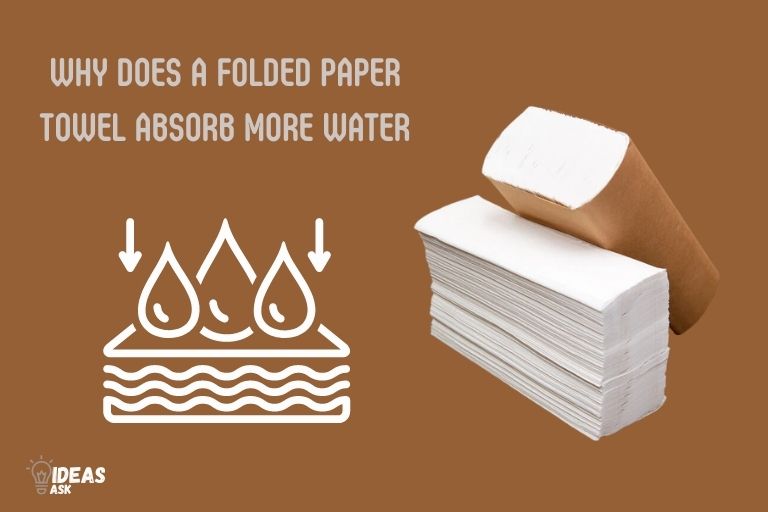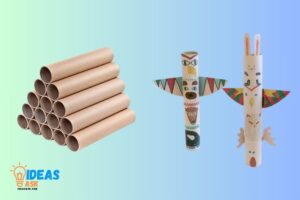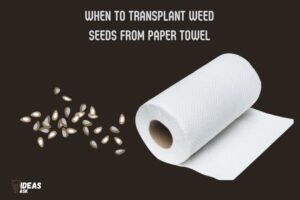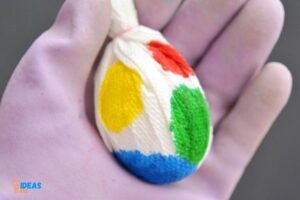Why Does a Folded Paper Towel Absorb More Water? Find Out!
A folded paper towel absorbs more water because it creates more surface area for water to be soaked up. This increased surface area allows the paper towel to absorb more water than a flat one.
The creases and folds in the paper towel create capillary action, which draws water into the tiny spaces between the folds, enhancing its absorbency.
Folding the paper towel increases its efficiency in soaking up liquid by providing more opportunities for water molecules to be captured.

Key Takeaway
Brief Explanation Of Paper Towels
What Are Paper Towels Made Of?
Paper towels are usually made from paper pulp that is highly absorbent, but the exact ingredients and manufacturing process can vary depending on the brand.
Some paper towel manufacturers use virgin wood pulp, while others may use recycled materials. They may also add other substances to increase absorbency or strength, such as chemicals, fillers, or coatings.
Regardless of the exact composition, paper towels are designed to be disposable and biodegradable.
History And Evolution Of Paper Towels
The first paper towels were invented in 1907 by a Philadelphia-based teacher named Arthur Scott. He discovered that a batch of improperly cut paper rolls from the factory could be used as a disposable, convenient alternative to cloth towels.
The idea quickly caught on, and Scott paper company soon began producing paper towels on a much larger scale.
Early paper towels were not as absorbent as today’s versions and were often made from recycled paper.
Over time, improvements in manufacturing and technology have made paper towels more effective and efficient.
Types Of Paper Towels And Their Uses
There are several different types of paper towels available for various uses.
Some popular types include:
- Basic paper towels: These are affordable and versatile, suitable for everyday messes and spills.
- Multi-fold paper towels: These are often used in public restrooms or other high-traffic areas where multiple people may need to use them.
- C-fold paper towels: These are similar to multi-fold towels but are folded in a different pattern, often making them easier to dispense.
- Kitchen or heavy-duty paper towels: These are more durable and absorbent, designed to handle larger spills or messes in the kitchen or other areas.
- Eco-friendly paper towels: These are made from recycled materials and are more sustainable than traditional paper towels.
- Decorative paper towels: These are often used for special occasions or events and may be printed with patterns or designs.
Choosing the right type of paper towel for the task at hand can help reduce waste and improve efficiency, while protecting the environment and minimizing costs.
How Does A Folded Paper Towel Absorb More Water?
Have you ever wondered why a folded paper towel can absorb more liquid than an unfolded one? Well, today we’ll be exploring the exciting science behind this phenomenon.
The Differences Between Folded And Unfolded Paper Towels
| Characteristic | Folded Paper Towel | Unfolded Paper Towel |
|---|---|---|
| Surface Area | Smaller surface area | Larger surface area |
| Absorbency | Absorbs less water due to reduced | Absorbs more water due to |
| surface area and layers. | increased surface area. | |
| Thickness | Often thicker and more layered, | Thinner and typically a single |
| providing added strength. | layer of paper. | |
| Portion Control | Easier to control the amount of | Less precise control over the |
| towel used for specific tasks. | amount of towel used. | |
| Convenience | Can be more convenient for tasks | May be more convenient for quick |
| that require precision, like | and simple cleanups or drying. | |
| wiping small spills. | ||
| Cost | May be more cost-effective in | Can be less cost-effective since |
| terms of usage per sheet. | more sheets are typically used. | |
| Storage | Takes up less storage space when | Requires more storage space, |
| folded, making it more organized. | especially when stored flat. |
These differences in characteristics between folded and unfolded paper towels can affect their suitability for various tasks and personal preferences.
The Role Of Absorption And Capillary Action
The absorption and capillary action of a folded paper towel are critical factors in its ability to absorb more water efficiently.
When the paper towel is folded, it creates numerous layers and creases. These small spaces between the folds act as capillaries, which are tiny channels or pores that can draw in and transport liquids.
Capillary action is driven by the combination of adhesive and cohesive forces in the paper towel, allowing it to “wick” water through the narrow spaces between the layers. This capillary action is akin to the way a sponge can pull water into its porous structure.
The increased surface area created by the folds provides more opportunities for capillary action to occur, enabling the paper towel to rapidly draw in and hold a larger volume of water.
As a result, folded paper towels are more effective at absorbing water, making them a practical choice for various cleaning and drying tasks.
The Role Of Hydrogen Bonds In Paper Towel Absorption
Hydrogen bonds are the forces that hold water molecules together. When water comes into contact with a paper towel, the strong hydrogen bonds between the water molecules are broken and replaced by weaker bonds between the water molecules and the paper towel fibers.
This causes the water to spread out on the surface of the towel and get absorbed into the towel’s fibers, allowing for more capillary action to take place.
Real-Life Demonstrations
Still unconvinced? Try this at home: take a folded paper towel and place it on top of a spill. Now, take an unfolded paper towel and lay it beside the folded one.
You’ll notice that the folded towel soaks up the liquid much faster and covers a more extensive range than the unfolded towel.
The next time you’re cleaning up a spill, remember that the way you fold your paper towel can make a big difference in your cleaning efforts. Happy cleaning!
Folded paper towels absorb more water due to their increased surface area, which enables capillary action through the tiny tubes created by the fibers. Hydrogen bonds between water and paper towel fibers also play a crucial role in absorption. So, next time you use a folded paper towel, remember the science behind it!
Effect Of Folding On Paper Towel Absorption
Increase In Surface Area Due To Folding
A folded paper towel absorbs more water than a flat one due to the increased surface area.
Here are some key points to help you understand it better:
- When a paper towel is folded, the surface area of the folded region increases, meaning there is more area for water to be absorbed.
- The tiny spaces between the folds of the paper towel create pockets, which allow more water to be held.
- When you fold a paper towel, you are essentially creating more layers to absorb the water, meaning that the towel can hold more.
Explanation Of How Folded Paper Towels Hold More Water And For Longer
Based on the above information, we can conclude that folded paper towels can hold more water than flat ones.
Here are some reasons why they can hold water for longer:
- The increased surface area means that more water can be absorbed, while the additional capillary action spreads the water evenly, allowing it to be held for longer periods.
- The pockets created by the folds of the paper towel are capable of holding water, keeping it trapped within the material.
- The extra layers created by folding the paper towel slow down the evaporation of water, ensuring that it stays moist and able to absorb more water for longer.
To summarize, the increased surface area due to folding and the introduction of additional capillary action in folded paper towels means that they can hold more water for longer periods than flat paper towels.
Comparison With Other Absorbent Materials
Everyone has used a paper towel at one time or another, whether it is for cleaning up spills in the kitchen, wiping down counters, or drying hands in public restrooms.
But have you ever wondered why a folded paper towel absorbs more water compared to other absorbent materials?
We will make a comparison with cloth, sponges, and napkins, highlight the pros and cons of using paper towels over other materials, and discuss why folded paper towels are so effective.
Comparison With Cloth
- Cloth towels are reusable and washable but absorb less water than paper towels.
- They are eco-friendly but require frequent washing and sanitizing to avoid bacterial growth.
- They are soft and comfortable to touch but take longer to dry and can spread germs if not properly washed.
Comparison With Sponges
- Sponges absorb more water than cloth towels but less than paper towels.
- They are versatile and can be used for different cleaning purposes but can be a breeding ground for bacteria if not cleaned and disinfected properly.
- They can be harsh on delicate surfaces and leave behind residue if not rinsed properly.
Comparison With Napkins
- Napkins are good for drying hands but not as effective for cleaning surfaces or spills.
- They are eco-friendly and come in different materials, including cloth, paper, and bamboo.
- They are easily disposable and hygienic, but they are not as absorbent as paper towels.
Pros And Cons Of Using Paper Towels Over Other Materials
Pros:
- Paper towels are disposable and convenient.
- They absorb more water than other materials.
- They are effective for cleaning surfaces and spills.
- They are hygienic and reduce the spread of germs.
- They are available in different sizes and types.
Cons:
- They are not very eco-friendly compared to cloth towels or sponges.
- They can be costly if used frequently.
- They contribute to waste and landfill.
- They require trees to be cut down for production.
While there are pros and cons to using paper towels, they remain an effective and convenient option for cleaning and drying.
The reason folded paper towels absorb more water than other absorbent materials is due to their porous surface and unique folding technique.
Many manufacturers use high-quality materials and production processes to create strong, absorbent paper towels that can handle even the toughest messes.
So next time you need to clean up a spill, reach for a folded paper towel and experience its superior absorbency for yourself.
Conclusion
A folded paper towel absorbs more water due to the capillary action of the tiny void spaces created by the folds.
This allows for more surface area to come in contact with water, resulting in a more efficient absorption process.
The science behind paper towel absorption may seem trivial, but it has its practical implications in our daily life.
Whether it’s cleaning up spills in the kitchen or wiping off sweat during exercise, folded paper towels are a convenient and efficient solution.
Moreover, understanding the scientific principles behind everyday phenomenon like this is crucial for developing our practical problem-solving skills.
So next time you reach for a paper towel, remember the simple yet fascinating science behind its absorbent properties.






